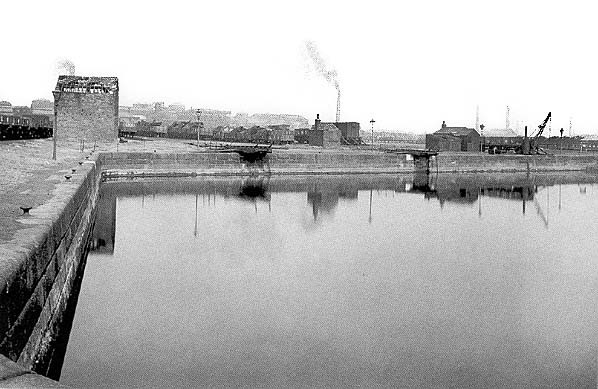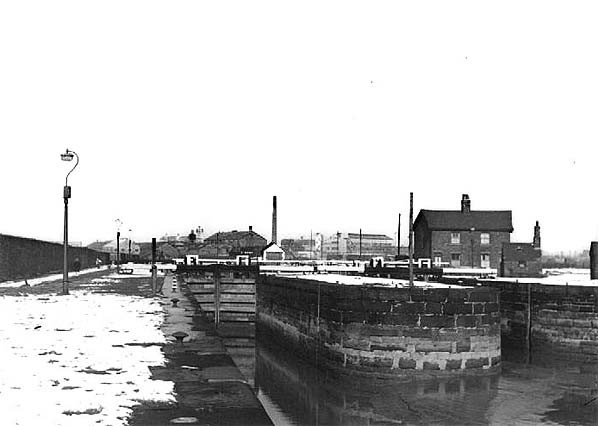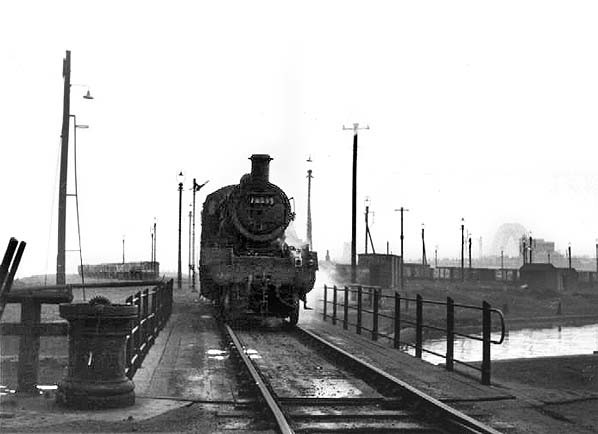
The entrance to Widnes Dock seen looking north in the early 1930s.
Widnes Dock was located at the southern end of the 1833 St Helens & Runcorn Gap Railway (SH&RGR) on the Lancashire side (north) of the River Mersey. The Runcorn Gap was a narrow point on the river at which a ferry connected West Bank in Lancashire to Runcorn in Cheshire . The SH&RGR was built primarily to move coal from the St Helens coalfield to the River Mersey for onward movement by river. The railway was built as a competitor to the Sankey Canal which had opened in 1757 for exactly the same purpose.
When the SH&RGR was authorised on 29 May 1830 the Sankey Navigation Canal Company had realised that they would be at a disadvantage as the canal entered the river three miles to the east of Runcorn Gap at Fiddlers Ferry. They obtained authorisation at the same time as the railway was authorised to extend the canal to Runcorn Gap.
The Widnes Dock built using sandstone blocks was connected to the tidal River Mersey by a single lock. It was capable of taking vessels capable of carrying 70 tons. The railway ran directly to the dock and five loading ramps were provided that allowed coal wagons to be tipped directly into the boats. This was first facility of this kind in the world. To the north of the dock there was a reservoir that kept the Widnes Dock water levels constant. There were also extensive areas of sidings which later became known as Marsh Sidings. To the north of the dock and the sidings at the point where the railway crossed the canal by means of a swing bridge a small settlement developed which by the 1840s included houses a pub, a chapel and a school. The settlement was known as the Widnes Dock township.
A train of coal wagons was run from St Helens to Runcorn Gap as a trial on 28 November 1832 and the line was opened formally on 21 February 1833. The dock however was not ready for the opening of the line and was not able to handle goods until August 1833. The Sankey Canal extension opened to Runcorn Gap on 24 July 1833. It reached the river by passing to the north of the dock and then swung south and connected to the river just to the west of it. The canal locks were adjacent to the Widnes Dock lock.

The SH&RGR and the Sankey Navigation Canal company began a price war that was damaging to both companies.
Within a month of the dock opening it was handling between 400 and 500 tons of coal per day. It was reported at the time that a vessel could be brought into the dock, have 70 tons of coal discharged into her from the railway wagons and within 40 minutes have her sails set and be on route for Liverpool. The dock could hold 40 vessels which gives an idea of its capacity.
By 1838 over 131,675 tons of coal passed through Widnes Dock along with just over 4,975 of general mechandise. Although such a large figure it amounted to a drop from the previous year.
On the 21 July 1845 the canal and railway companies merged as the St Helens Canal and Railway Company (SHC&RC). The merger brought an end to the price war that had nearly bankrupted both companies. Stability allowed improvements to the original line and extensions to Garston and Warrington to be undertaken A new Dock at Garston opened on 21 June 1853 which was able to take deep water vessels. Widnes Dock declined in importance after this date. Much of the river traffic that did continue to come up to Widnes used the larger West Bank Dock.
The area around Widnes Dock had developed with industry from 1847 when John Hutchinson opened a chemical works alongside the canal. The works was served by both the canal and the railway. Further factories opened up within twenty years and the town of Widnes began to develop.
On 31 July 1864 the London & North Western Railway (LNWR) took over the SHC&RC and they invested £100,000 in the railway at Widnes. By the end of the 19th century Widnes was the largest chemical manufacturing centre in Great Britain. By the 1920s though there was nothing left of the Widnes Township.

Widnes Dock was last used commercially in 1931. The closure of the dock did not bring an end to the rail activity at the Marsh Sidings as they were an ideal location to store wagons and to marshal trains.
The Sankey Canal closed from Earlestown to St Helens in 1931. The remaining section from Runcorn Gap to Earlestown remained in use until 1959 when sugar traffic ended. It was closed in 1963. By this time the Widnes Dock had been filled in.
As part of British Railways from 1 January 1948 the Marsh Sidings remained busy until the 1960s when traffic levels began to decline. The sidings closed on 4 November 1968 when the line from Widnes Dock Junction to Widnes Dock was taken out of use. The sidings were lifted shortly after. In the late 1970s work began on the creation of a park that included the Sankey Canal, Widnes Dock and the Marsh Sidings area. The park called Spike Island opened in 1982. The Widnes dock was excavated and cosmetically restored but not completely so as to give a shallower depth of water. The Sankey Canal adjacent to the dock was converted into a marina.
Spike Island became famous in the rock music world when the Stone Roses played an outdoor concert on the site of the 'Marsh Sidings' on 12 August 1989. Over 27,000 people packed onto Spike Island for the event that in 2012 was the subject of a film called 'Spike Island'.
For more information about the Sankey Canal click here.
Sources:
- The St Helens Railway, Its Rivals and Successors – J M Tolston – The Oakwood Press 1982
- The Widnes to St Helens Railway in Halton 1833 - 1982 - P T Wright - Halton Borough Council 2008
See Also:
Widnes Dock Junction and Runcorn Gap

Widnes Dock looking north in the early 1930s shortly after it had fallen out of use. On the far side of the dock can be seen the loading system that had been used to transfer coal from rail to water.

The entrance to the Sankey Canal at Widnes seen in 1959. Widnes Dock was to the right just out of sight.
Copyright photo
from the Harry Arnold Archive

Looking south towards Widnes Dock from the Sankey Canal swing bridge in 1962. On the far side of the canal the marsh sidings can clearly be seen. Widnes Dock was beyond the sidings but at this time it was filled in having fallen out of use in 1931.
Copyright photo
from the Harry Arnold Archive
.jpg)
The same view as the picture above seen on 17 July 2012.
Photo
by Paul Wright
.jpg)
Widnes Dock seen from the in filled entrance lock looking north on 17 July 2012. The dock was cosmetically restored in the early 1980s as part of the Spike Island public park.
Photo
by Paul Wright
|

